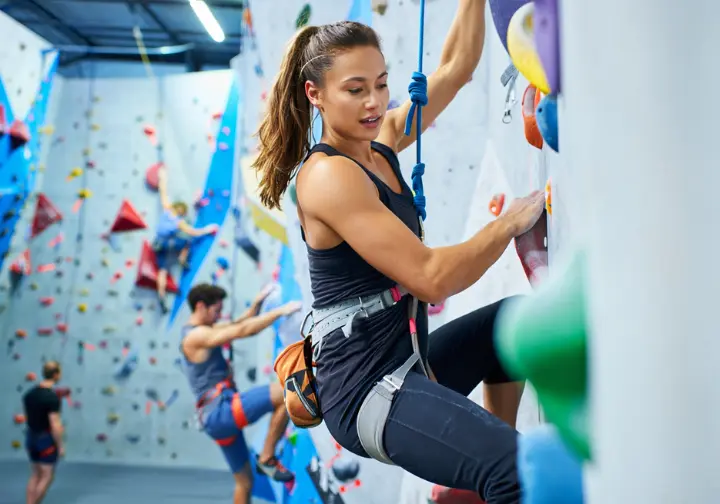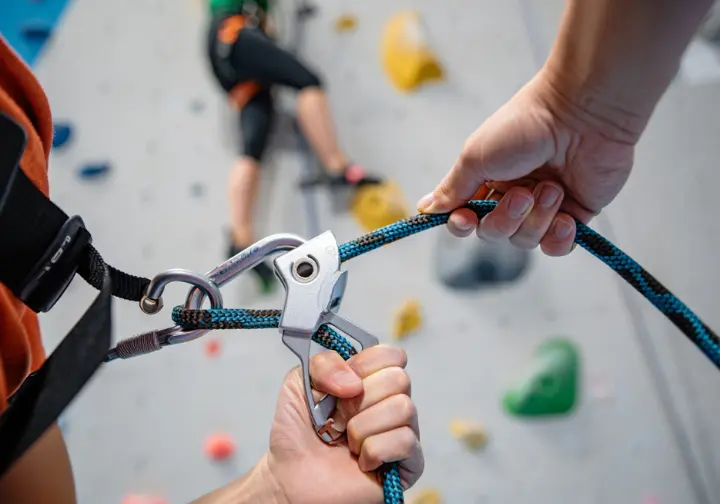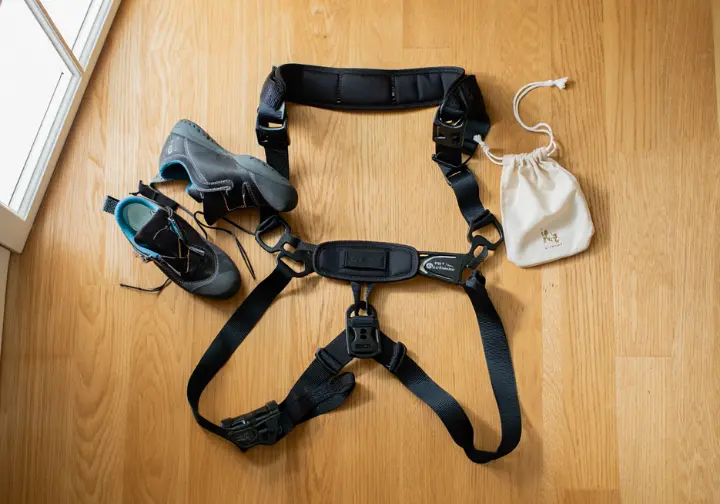In this article
For the dedicated rock climber facing a new crux, pregnancy brings a wave of questions. A central one is how to navigate the world of rock climbing and pregnancy. This isn’t about a simple “yes or no” answer. It’s about understanding that you can embrace your identity as both an athlete and an expectant mother—a mama climber—through a process of careful risk management, not complete risk elimination. We’re moving beyond simplistic warnings to provide a comprehensive, evidence-based framework for your journey into motherhood.
You will find an actionable, trimester-by-trimester plan for making safe and empowered decisions. It all hinges on a foundation of expert medical guidance, the collected wisdom of the climbing community, and the most important tool you have: the ability to listen to your own pregnant body.
The Foundational Decision: To Climb or Not to Climb?

Before you even touch the rock, it’s crucial to establish the foundational principles of this journey. You need to understand the expert consensus on who should consider climbing during pregnancy, how to frame the balance of benefits versus risks, and the non-negotiable first step of consulting with your medical team.
The “Do What You Know” Principle: Why Experience Matters
The consensus among medical professionals and expert climbers is clear: an ordinary pregnancy is not the time to start a new, high-risk sport. The guidance is explicitly for experienced climbers who already possess a high degree of body awareness. A pre-existing foundation of climbing-specific skills, ingrained muscle memory, and an intuitive understanding of movement are the critical prerequisites for safely adapting to the profound changes of pregnancy.
This stands in stark contrast to taking up a new, low-impact activity like swimming or walking, which is often recommended as safe exercise during pregnancy. The inherent fall risk in climbing places it in a different category that demands prior expertise from any female rock climber. If you’re a new climber, seeking out professional instruction for new climbers and building your skills first is the safest path forward.
Benefits vs. Risks: A Balanced Perspective
Continuing your climbing routine through pregnancy offers significant mental and emotional benefits. For many avid climbers, the sport is a core part of their identity. Staying engaged helps manage stress, maintain that crucial sense of self, and stay connected to a supportive community of climbing partners. These psychological advantages are a powerful reason to find a safe way to continue an active pregnancy.
However, these benefits must be weighed against the primary physical risks. The most acute risk is placental abruption—a serious condition that can result from the impact of a fall and harm the fetus. A more chronic risk involves joint and ligament injury, as the pregnancy hormone relaxin makes these tissues more susceptible to sprains and strains. This isn’t a simple pro/con list; it’s an ongoing, dynamic risk assessment that will evolve with each trimester and your unique journey.
The Medical Consultation: Your First, Most Important Move
Your first and most important move is a thorough consultation with your healthcare provider. An OB-GYN or midwife can provide medical clearance based on your personal health profile, screen for issues like gestational hypertension disorders, and rule out contraindications like high blood pressure in pregnancy. This is the non-negotiable first step before you make any decisions about your climbing goals.
To make this conversation productive, especially with a non-climbing professional, you need to be an advocate for your own sport. Explain the critical differences in risk between bouldering, lead climbing, and top-roping. Consider building a broader healthcare team; a Women’s Health or Pelvic Floor Physical Therapist can offer highly specialized, athlete-focused guidance. The goal is to create a partnership in safety, informed by both medical expertise and your deep knowledge of climbing. For more on official recommendations, see the guidance on Physical Activity and Exercise During Pregnancy.
The Trimester Roadmap: Your Changing Body and Climbing Strategy

Your body and your climbing will evolve dramatically throughout your entire pregnancy. Your strategy must adapt in response with a detailed trimester-by-trimester breakdown of the key physiological changes, the associated risks, and the necessary modifications to your climbing practice.
First Trimester (Weeks 1-13): The Invisible Shift
During the first trimester, the changes are largely hormonal and internal. The hormone relaxin begins to increase ligament laxity throughout your body, making joints less stable and more prone to injury on tweaky climbs. This is why a proper warm-up becomes more critical than ever. Many also experience intense nausea and fatigue, which can significantly impact performance and motivation.
A primary concern during this period is the risk of miscarriage. It is crucial to understand that most early miscarriages are due to chromosomal abnormalities, not physical activity like climbing. However, given that this is a vulnerable phase for fetal growth, avoiding hard, unexpected falls is a prudent measure to prevent a potential abortion. This can create a social challenge, as you may find yourself modifying your climbing while keeping your pregnancy private before the 12-week mark.
Second Trimester (Weeks 14-27): The Physical Transformation
The second trimester marks a period of major physical change. Your uterus rises above the protective shield of the pelvis, your belly becomes more noticeable, and your center of gravity begins to shift, fundamentally altering your balance and movement on the climbing wall. This is the critical period for making significant modifications to your roped climbing.
This is the point when most experts and professional climbers strongly advise stopping both lead climbing and bouldering. The risk of a direct impact to the abdomen is now too significant to ignore.
The single most important change you must make is switching to a full-body pregnancy harness. This specialized piece of gear is designed to move all pressure away from your growing abdomen and distribute it across your chest and back. Understanding the principles of A properly fitting climbing harness is the foundation for making this essential switch.
Third Trimester (Weeks 28-40+): The Final Ascent
In the third trimester of pregnancy, the physical changes of the second trimester become amplified. Your balance is significantly compromised, fatigue and shortness of breath are more pronounced, and swelling in your hands and feet is common. This swelling can make your climbing shoes feel tight and uncomfortable, underscoring the importance of a shoe that respects your individual foot anatomy.
For most climbers, the sheer logistics of moving with a large belly and the general gestational weight gain become the primary limiting factors. These changes naturally curtail the intensity and frequency of climbing. If you do continue, it should be restricted to gentle top rope on routes well below your pre-pregnancy grade. The focus must shift entirely from performance to enjoyment and movement, in line with general guidelines for Exercise in pregnancy and the postpartum period.
Practical Risk Mitigation: A Discipline-by-Discipline Guide

Translating theory into action is the practical core of risk mitigation. Breaking down the specific risks and recommended safety protocols for each climbing discipline, and detailing the crucial technique modifications for protecting your core, are essential next steps for all pregnant women.
Bouldering: Managing High-Impact Risk
Bouldering, by its very nature, presents the highest risk of abdominal trauma. Even with crash pads, falls are often hard, uncontrolled, and from various heights. The primary medical concern from such an impact is placental abruption, a severe condition that poses a direct threat to the pregnancy and fetus. Because of this, the consensus advice from the professional climbing industry is clear: stop bouldering after the first trimester.
For those who may consider continuing a highly modified version of this short, specific climbing route, the safety protocol must be exceptionally strict. This means only easy bouldering, traversing low to the ground, with your feet never more than a foot or two off the deck. It requires never topping out and always downclimbing in a controlled manner, surrounded by multiple, well-placed crash pads.
Lead & Top-Rope Climbing: The Switch to Safety
Lead climbing introduces dynamic forces and unpredictable falls. Even a small lead fall can generate significant impact against the wall, posing a risk to the abdomen. For this reason, it is strongly advised to stop all lead climbing by the second trimester. The safer alternative, and the universally recommended method for climbing during the second and third trimesters, is top-roping.
Because the rope is anchored above you, top-roping is the ideal introduction to the sport for beginners and the gold standard for safety during pregnancy. It minimizes fall distance and impact forces, creating a much more controlled environment for any sport climbing. This safety, however, relies heavily on a trusted and attentive belayer—a consistent climbing partner is invaluable. Your partner must be instructed to keep the rope relatively tight, eliminating slack to ensure that even small slips don’t become actual falls.
Core-Safe Technique: Preventing Diastasis Recti & Injury
As your abdomen expands, your core muscles stretch and become more vulnerable. It’s essential to manage intra-abdominal pressure (IAP) to protect them. High-exertion movements common in climbing—like hard pulling, campusing, or dynos—can cause a harmful spike in IAP, which contributes to Diastasis Recti, the separation of the abdominal muscles.
[PRO-TIP] Watch your stomach during core-intensive movements. If you see a “coning” or “doming” shape emerge down the midline of your abdomen, that is a visual sign that your deep core is not managing the pressure correctly. Stop the movement immediately and adjust your technique.
The simplest and most powerful tool for managing IAP is your breath. Make it a rule to always exhale on exertion. This simple action helps engage the deep transverse abdominis muscles and stabilizes the core safely. A focus on A strong core for boulderers can provide a great foundation, but the exercises must be adapted for pregnancy, with guidance on proper Pelvic floor and stomach exercises in pregnancy.
Gear Up for Two: The Essential Equipment Guide

As your body changes, so must your gear. The focus now shifts to the single most important piece of adapted equipment—the full-body harness. A detailed comparison of popular models will help you make the best choice.
The Full-Body Harness: Why and When to Switch
A standard sit harness is designed to concentrate pressure directly on the hips and pelvic region. As your abdomen grows, this design becomes both uncomfortable and unsafe. The waistbelt can constrict your belly, creating a dangerous pressure point. For this reason, safely continuing rock climbing during pregnancy requires a mandatory gear change.
A full-body harness is specifically engineered to solve this problem. It completely avoids pressure on the abdomen by redistributing the force of a fall or the weight of hanging across the structure of your upper chest, shoulders, and back. The guideline is to make the switch around the start of the second trimester (typically 16-20 weeks), or as soon as your regular harness begins to feel tight or restrictive.
Harness Comparison: Mad Rock Mountain Mama vs. Petzl 8003
Choosing the right full-body harness is a critical decision. The two most commonly discussed models are the Mad Rock Mountain Mama and the Petzl 8003. While both are safe, they offer very different experiences, and few climbing gyms rent pregnancy-specific models.
Mad Rock Mountain Mama vs. Petzl 8003 Full Body Harness
A comparison of two full-body harnesses, focusing on their design, comfort, adjustability, and more.
Mad Rock Mountain Mama
Pros
- Comfortable, good range of motion
- Specifically designed for a pregnant body
- Padded leg loops
- Highly adjustable straps to accommodate a growing belly
Cons
- Expensive (~$120)
- Buckles may loosen during a session
- Single gear loop is insufficient for cleaning routes
Petzl 8003 Full Body Harness
Pros
- Functional, widely available
- Keeps climber upright and safe
- Fully adjustable shoulder and leg loops
- Relatively affordable (~$90 – $100)
Cons
- Unpadded webbing can be uncomfortable and cause chafing
- Awkward buckle placement on leg loops
- Not pregnancy-specific
- Tie-in point can feel awkward
- Smaller climbers may find even the smallest size too long in the torso
- Gear loops are small and awkwardly placed for racking gear
While many climbers have trusted Petzl for years because Petzl climbing harnesses are known for innovation, the user consensus is clear: the Mountain Mama’s pregnancy-specific design provides superior comfort, making it a worthwhile investment if you plan to climb consistently.
The Postpartum Climb: A Guide to Your Return

The journey doesn’t end at birth. The postpartum period, often called the “fourth trimester,” is a critical phase of recovery and rebuilding. Setting realistic expectations and outlining a patient, phased approach to returning to the sport you love is paramount for all postpartum climbers.
The “Fourth Trimester”: A Phased and Patient Return
It is vital to set a realistic timeline for recovery. The standard six-week medical checkup that clears you for daily activity is not a green light for an immediate return to high-intensity training or climbing. A gradual, phased approach is essential for long-term health and a successful return to the sport after childbirth. The journey should begin with foundational work like walking and gentle core reconnection exercises. Only after building that base should you progress to light bodyweight movements and eventually, easy climbing.
The experiences of professional climbers, like former pro-climber Beth Rodden, highlight the immense variability of postpartum recovery. The timeline depends heavily on factors like the type of birth (vaginal vs. C-section), the presence of any complications, and individual healing. Following a smart rock climbing training program that is adapted for the postpartum body is key, as is understanding the principles of Maximizing Recovery in the Postpartum Period.
Postpartum Challenges: Diastasis Recti & Pelvic Floor Health
A majority of postpartum women experience Diastasis Recti, a separation of the abdominal muscles. You can perform a self-check for this condition, and it’s crucial to avoid exercises that can worsen it (like crunches). The single most valuable resource for any postpartum athlete is a Pelvic Floor Physical Therapist. They can provide a personalized assessment and create a rehabilitation plan for both diastasis recti and any pelvic floor trauma sustained during birth.
A full recovery involves more than just waiting. It requires active rehabilitation to regain core stability and strength. Once you have been cleared by a medical professional and have rebuilt your foundation, you can begin to re-integrate Targeted strength training into your routine. Understanding how to perform safe Pregnancy exercises to strengthen your pelvic floor is a great place to start.
Conclusion: Climb On, Mama
Climbing through pregnancy and beyond is a deeply personal journey. It demands a fundamental shift from a mindset focused on performance and grades to one centered on maintenance, connection, and enjoyment. Your most important tools are not your harness or your climbing shoe; they are open communication with your medical team, a deep and honest connection with your own body, and a trusted, attentive climbing partner.
Empower yourself with knowledge to manage risks effectively. This will allow you to maintain a vital part of your identity in a way that is both safe and responsible. Remember that the postpartum return to climbing is a marathon, not a sprint. Be patient and kind to your body as it recovers and rebuilds its incredible strength. The rock will be waiting for you.
Frequently Asked Questions about Rock Climbing and Pregnancy
Can you rock climb in the first trimester?
Yes, many experienced climbers continue to climb in the first trimester, but with significant modifications. It’s crucial to get clearance from your doctor and to focus on avoiding falls, as this can help prevent complications, even though the risk of miscarriage is not typically activity-related.
When should you stop bouldering when pregnant?
Most medical experts and professional climbers strongly advise stopping bouldering after the first trimester. This is because the risk of abdominal trauma from a hard, uncontrolled fall becomes too high once the uterus grows above the pelvis, which could lead to preterm birth.
Do you have to use a full-body harness while pregnant?
Yes, switching to a full-body harness is considered a mandatory safety step, typically started around the second trimester. It moves pressure away from the growing belly and distributes weight across the chest and shoulders, which is essential for both safety and a comfortable pregnancy.
What is a realistic timeline for returning to climbing after giving birth?
The timeline is highly individual and can take many months. While medical clearance for gentle activity may come at 6 weeks, a full return to climbing requires a patient, phased approach. Starting with core and pelvic floor rehab before slowly progressing is the safest path for mothers.
Risk Disclaimer: Rock climbing, mountaineering, and all related activities are inherently dangerous sports that can result in serious injury or death. The information provided on Rock Climbing Realms is for educational and informational purposes only. While we strive for accuracy, the information, techniques, and advice presented on this website are not a substitute for professional, hands-on instruction or your own best judgment. Conditions and risks can vary. Never attempt a new technique based solely on information read here. Always seek guidance from a qualified instructor. By using this website, you agree that you are solely responsible for your own safety. Any reliance you place on this information is therefore strictly at your own risk, and you assume all liability for your actions. Rock Climbing Realms and its authors will not be held liable for any injury, damage, or loss sustained in connection with the use of the information contained herein.
Affiliate Disclosure: We are a participant in the Amazon Services LLC Associates Program, an affiliate advertising program designed to provide a means for us to earn advertising fees by advertising and linking to Amazon.com. As an Amazon Associate, we earn from qualifying purchases. We also participate in other affiliate programs. Additional terms are found in the terms of service.











